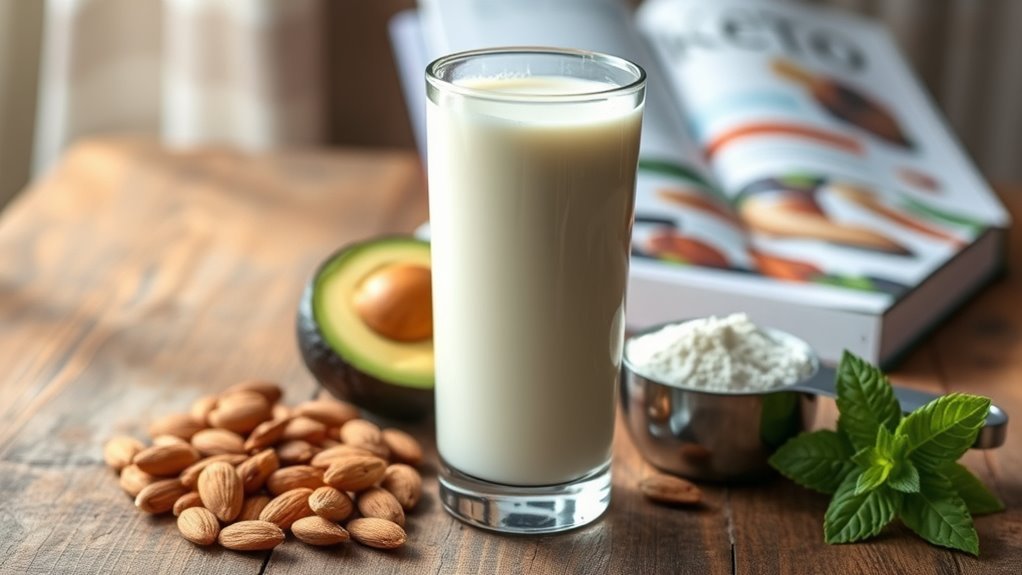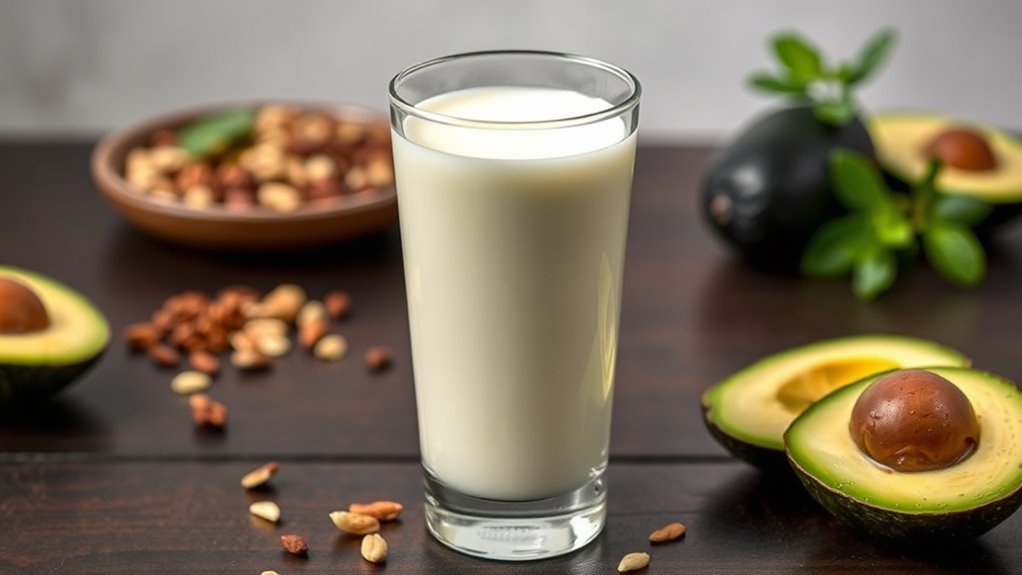Lactose-free milk isn’t the most keto-friendly option for you, mainly due to its 12 grams of carbohydrates per cup, which can hinder your ability to stay in ketosis. While it offers similar nutrients to regular milk, those carbs can add up quickly. If you’re looking for lower-carb alternatives, almond or coconut milk might be better choices. Understanding the nutritional differences can help you make informed decisions about your diet, and there’s more to explore on this topic.
Understanding the Ketogenic Diet

While many people are drawn to the ketogenic diet for its potential weight loss benefits, understanding its underlying principles is vital for success. The core of a ketogenic diet is high fat, moderate protein, and very low carbohydrates, which shifts your body into ketosis—a state where it burns fat for fuel instead of carbs. This shift can lead to several keto benefits, including increased energy levels and reduced hunger. However, it’s important to recognize dietary restrictions, as not all foods fit into this framework. You’ll want to prioritize healthy fats, avoid processed foods, and choose low-carb vegetables. By familiarizing yourself with these principles, you can navigate the ketogenic landscape more freely and effectively, enhancing your overall experience.
What Is Lactose-Free Milk?

Lactose-free milk is a specially processed dairy product designed for individuals who are lactose intolerant, meaning they have difficulty digesting lactose, the sugar found in regular milk. It’s made by adding lactase, an enzyme that breaks down lactose into simpler sugars, making it easier to digest. This can alleviate common lactose intolerance symptoms like bloating, gas, and diarrhea. If you’re seeking dairy alternatives, lactose-free milk offers a similar taste and texture to regular milk, allowing you to enjoy your favorite recipes without discomfort. It’s a great option for those who want to maintain a dairy-rich diet while avoiding the adverse effects of lactose. With lactose-free milk, you can embrace delicious options without sacrificing your well-being.
Nutritional Breakdown of Lactose-Free Milk

When evaluating lactose-free milk, understanding its nutritional profile is essential for making informed dietary choices. Lactose-free milk typically contains similar nutrients to regular milk but with reduced lactose content, making it easier to digest for those with lactose intolerance. A standard serving provides about 8 grams of protein, 12 grams of carbohydrates, and essential vitamins like calcium and vitamin D. While it’s nutritionally comparable to cow’s milk, keep in mind that some milk alternatives, such as almond or coconut milk, may offer lower calories and different nutrient profiles. If you’re mindful of carbs for keto, you might want to assess how lactose-free milk fits into your overall daily intake and how it compares to other milk alternatives.
Comparing Carbohydrate Content
Understanding the carbohydrate content in lactose-free milk is important for anyone following a keto diet. While it’s a popular choice for those with lactose intolerance, you might be curious about how it stacks up against other milk alternatives regarding carbs.
Here’s a comparison:
| Type of Milk | Carbohydrates (g) per 1 cup | Notes |
|---|---|---|
| Lactose-Free Milk | 12 | Similar to regular milk |
| Almond Milk | 1-2 | Low carb, popular choice |
| Coconut Milk | 6 | Creamy, moderate carbs |
| Soy Milk | 4-6 | A good protein source |
When considering your carbohydrate sources, these alternatives can help you maintain your keto lifestyle while enjoying milk-like options.
Lactose-Free Milk and Ketosis
When considering lactose-free milk in relation to ketosis, it’s essential to examine its nutritional profile compared to regular milk. While lactose-free milk has similar carbohydrate levels, it may still affect your state of ketosis, depending on your overall daily carb intake. Understanding these nuances can help you make informed choices that align with your keto goals.
Nutritional Profile Comparison
While lactose-free milk can be a suitable option for those with lactose intolerance, its nutritional profile warrants careful consideration for anyone following a ketogenic diet. Typically, lactose-free milk contains similar carbohydrate levels as regular milk, with about 12 grams of carbs per cup. This amount can hinder ketosis, the metabolic state sought in a keto lifestyle. Although it’s easier to digest for some, you might want to explore milk substitutes like almond or coconut milk, which often have lower carbohydrate content. These alternatives can help you maintain your desired macronutrient balance. Ultimately, understanding the nutritional differences in these options is essential for making informed choices that align with your health goals while enjoying the freedom of diverse diets.
Impact on Ketosis
Although many people with lactose intolerance might consider lactose-free milk a safe alternative, its impact on ketosis shouldn’t be overlooked. When you’re aiming for ketosis, the carbs in lactose-free milk can still affect your state of ketosis. While it’s lower in lactose, it still contains some carbohydrates, which can lead to ketosis effects that might stall your progress. If you’re seeking dairy alternatives, options like unsweetened almond or coconut milk can provide a lower-carb solution. These alternatives typically contain fewer carbs, making them more compatible with a ketogenic lifestyle. Ultimately, if you choose lactose-free milk, be mindful of portion sizes to maintain your goals while enjoying the creamy texture it offers. Balancing choices is key to your keto journey.
Alternatives to Lactose-Free Milk
If you’re looking for alternatives to lactose-free milk, there are several options that can fit into a keto diet while providing similar nutritional benefits. Here are some great choices:
- Almond Milk: Low in carbs and calories, it’s a popular choice for those on keto.
- Coconut Milk: High in healthy fats, it can add richness to your recipes.
- Hemp Milk: Packed with omega-3 fatty acids, it’s a nutritious, dairy-free option.
Other options include soy milk and cashew milk, both of which can be suitable depending on your dietary preferences. Macadamia milk is another high-fat alternative that complements a keto lifestyle. Each option has its own flavor and nutritional profile, so feel free to experiment and find what works best for you!
Incorporating Lactose-Free Milk Into Your Diet
How can you seamlessly incorporate lactose-free milk into your diet? Start by using it as a milk substitute in your favorite lactose-free recipes. Whether you’re making creamy soups, sauces, or smoothies, this milk can enhance flavors while keeping your meals keto-friendly. You can also enjoy it in coffee or tea, ensuring your morning routine remains satisfying without the discomfort of lactose. Consider using lactose-free milk in baking too; it works well in low-carb recipes for pancakes or muffins. Just remember to be mindful of your overall carb intake. By integrating lactose-free milk into these meals, you’ll not only enjoy its benefits but also maintain the flexibility and freedom you desire in your keto journey.
Personalizing Your Keto Approach
While starting on a keto journey, personalizing your approach is essential for achieving sustainable results. Everyone’s body responds differently, so it’s vital to take into account your personal preferences and make dietary adjustments accordingly. Here are some factors to keep in mind:
- Macronutrient Ratios: Find the right balance of fats, proteins, and carbs that works for you.
- Food Choices: Explore various keto-friendly foods, including lactose-free options, to see what you enjoy most.
- Lifestyle Factors: Assess your activity level and daily routine, as these influence your nutritional needs.
Frequently Asked Questions
Can Lactose-Free Milk Cause Digestive Issues for Lactose Intolerant Individuals?
Imagine a delicate flower wilting under too much sun—this is how your digestive health might feel with lactose intolerance. Even though lactose-free milk is designed to ease symptoms, it can still cause discomfort for some. Since your body might react to other components or additives, you may experience bloating or gas. It’s crucial to listen to your body and consult a healthcare professional to guarantee you’re making choices that support your well-being.
Is There a Difference in Taste Between Regular and Lactose-Free Milk?
When you consider the taste comparison between regular and lactose-free milk, you might notice subtle differences in their flavor profiles. Lactose-free milk often tastes slightly sweeter due to added enzymes that break down lactose into simpler sugars. However, many people find the difference negligible, especially in recipes or when consumed in coffee. Ultimately, it comes down to personal preference, so trying both can help you determine which one you enjoy more.
Can I Use Lactose-Free Milk in Keto Desserts?
Imagine diving into a rich, creamy keto dessert, where each bite melts like velvet on your tongue. You can definitely use lactose-free milk as a versatile ingredient in your keto dessert recipes. It serves as an excellent lactose-free alternative, maintaining a similar flavor profile to regular milk. Just keep an eye on the carb content, as some brands may vary. With the right choices, you’ll enjoy delightful treats without compromising your keto goals!
How Does Lactose-Free Milk Affect Blood Sugar Levels?
Lactose-free milk can impact your blood sugar levels differently than regular milk. Since it’s processed to remove lactose, your body doesn’t have to digest it, leading to a potentially steadier blood sugar response. However, it still contains carbohydrates, so monitoring portion sizes is essential. While many find it manageable, individual responses can vary, so it’s wise to check how your body reacts. Enjoy the freedom to incorporate it mindfully into your diet!
Are There Any Added Sugars in Lactose-Free Milk?
When you look at lactose-free milk, you’ll find that it’s often similar in nutritional profile to regular milk. However, ingredient comparison is key; some brands may add sugars or flavorings to enhance taste, which can increase the sugar content. It’s crucial to read labels carefully to guarantee you’re choosing a product that fits your dietary needs. Overall, while lactose-free milk can be a good option, not all varieties are created equal.


